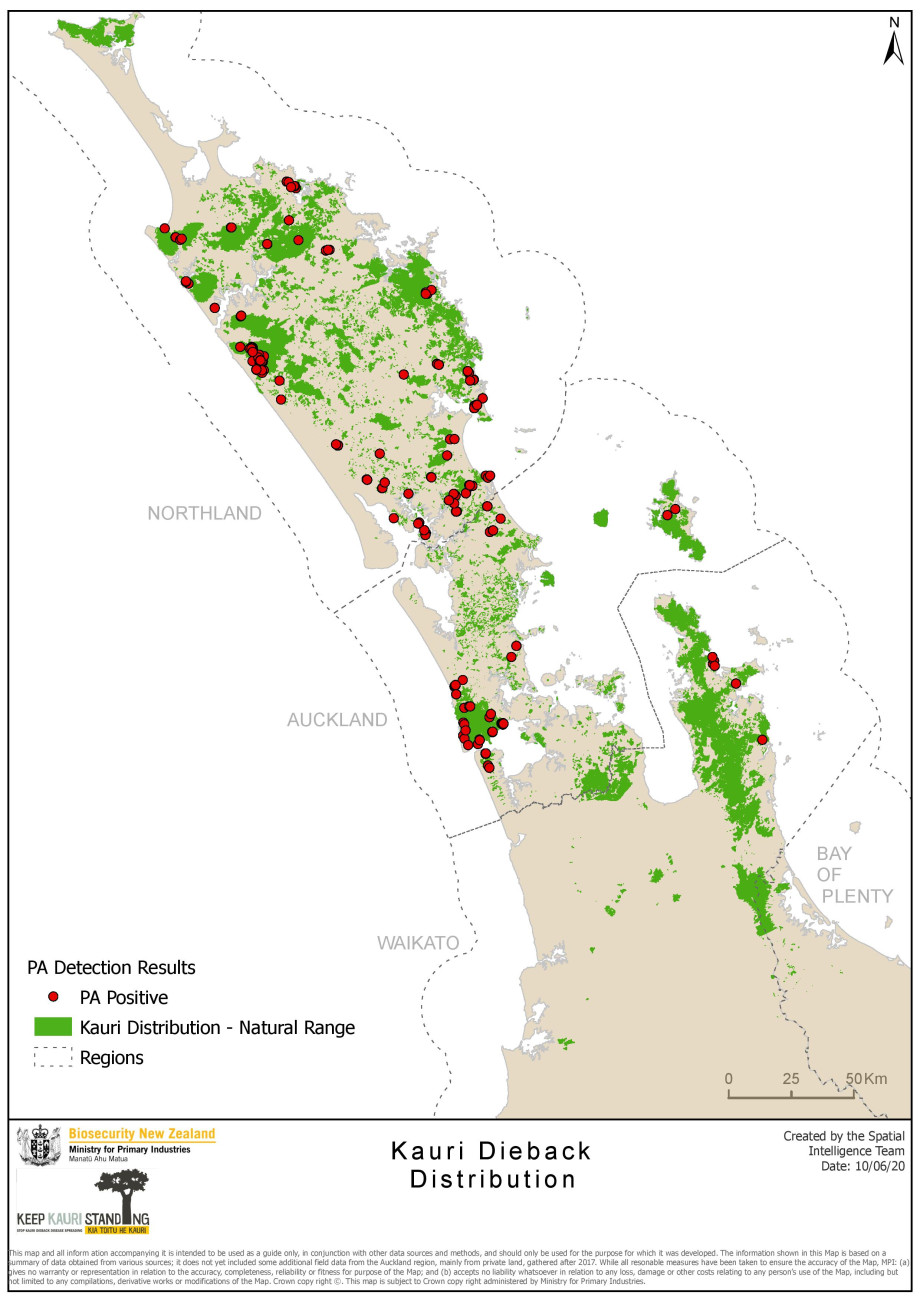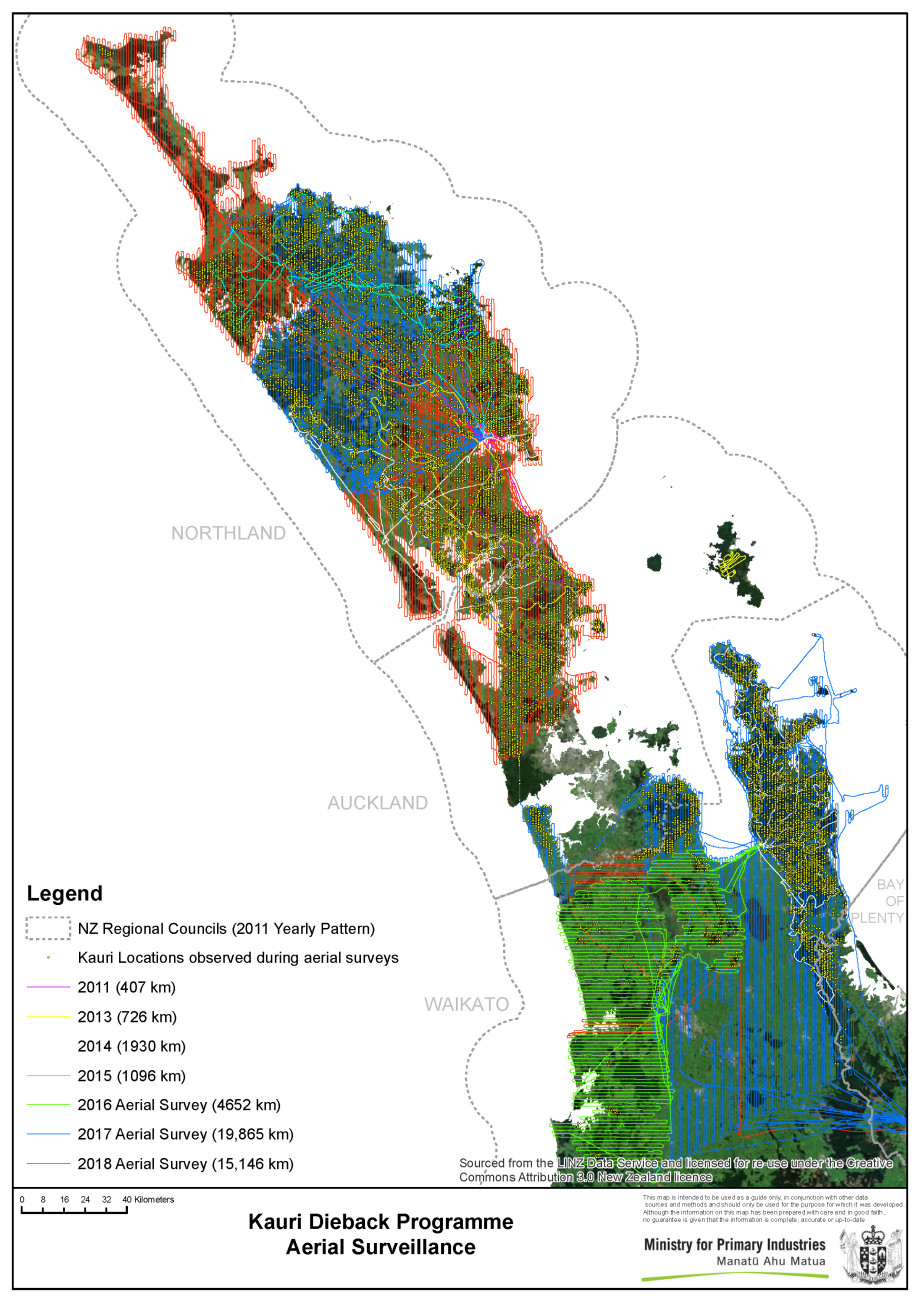Kauri and disease distribution
Knowing how the disease caused by the pathogen Phytophthora agathidicida (PA) spreads, underpins what tactics and tools are required to find where the disease is located.
How Phytophthora agathidicida (PA) is spread
The disease is soil-borne and can spread long distances with the movement of contaminated soil. It also spreads naturally through soil water. It can also spread by root-to-root contact because a lot of kauri grown in kauri stands have their roots interconnected and through movement of infected kauri wood. There is no evidence to suggest the disease can be transmitted in kauri seeds or cones unless they are contaminated with soil.
Although we have not detected the pathogen in water bodies such as streams or creeks, it is possible the pathogen can disperse downstream especially in times of flooding.
Laboratory research has found that pigs can also act as vectors (or transmitters) of the pathogen although the level of risk is uncertain at this stage.
Only kauri have been found to be infected by the pathogen although laboratory research suggests other native plant species may be suitable hosts. Extensive field trials are currently underway to validate these research findings and to determine if other plant species can host or carry the pathogen.
Human activities are responsible for the largest spread of the pathogen. A number of observational studies imply that the movement of contaminated soil on people and associated vehicles and equipment, represent the greatest risk of spread. Given the high frequency of visitors to the forest and the type of activities being carried out, it increases the likelihood of large amounts of contaminated soil being removed inadvertently from within and between kauri forests.
Aerial and ground surveillance research
Aerial and ground surveillance (via soil sampling and tree surveys) are a large component of our operations. Finding the pathogen involves locating trees with disease symptoms using remote sensing and aerial photography and confirming whether these symptomatic trees are infected with the pathogen through ground surveillance.
Early research focused on developing tools that enable us to accurately diagnose the pathogen from the soil as well as an understanding of the spatial distribution of the pathogen in and around kauri. This has allowed us to optimise laboratory methods and sampling tactics to increase the likelihood of detecting the pathogen as well as guidelines to manage the risks associated with certain activities in the forest.
We know that the disease has a patchy distribution, across most regions where kauri are found but we are less certain in knowing if a forest or an area of the forest or even an individual tree is completely disease-free. It is impractical to sample and test all soil around kauri due to the time and cost involved. And given there is a lag time (or delay) between when a tree becomes infected to when disease symptoms appear makes it even more difficult to ascertain whether a tree is infected or not. Consequently, we are taking a precautionary approach in disease control and management, in treating all kauri as potentially infected.
Ongoing research aims to test and refine existing diagnostic and surveillance tools and to explore potentially innovative new ones, which are more cost effective and allow us to diagnose the pathogen and find the disease more rapidly. We are also exploring other ways in how we define an area free of the disease. The use of epidemiology, remote sensing and Cultural Health Indicators are some examples currently being explored.
See our Research database for a complete library of research and reports.
Ground surveillance
This map shows the general known locations of kauri trees and areas of disease. Tiakina kauri is working with our partners to increase the extent of our kauri and pathogen distribution and disease mapping.
It shows the results of soil testing carried out after the Kauri Protection Programme’s aerial surveillance identified an area that should be investigated.
Areas marked PA Positive are those where soil testing for the presence of PA has returned a positive result.

The full extent of the disease is likely to be greater than the extent of confirmed PA infection because infected kauri trees may not show symptoms of disease for up to 10 years, or even longer.
This map has been developed from the latest information supplied to Biosecurity New Zealand by Kauri Protection Programme partners. * **
Testing work is continuing in many areas, so the picture of disease spread will change as we gather more information.
* This map is intended to be used as a guide only, in conjunction with other data sources and methods, and should only be used for the purpose for which it was developed. Although the information on this map has been prepared with care and in good faith, no guarantee is given that the information is complete, accurate or up-to-date.
** This map does not include some additional field data from the Auckland region, mainly from private land, gathered after 2015.
Aerial surveillance
The Kauri Protection Programme uses aerial surveillance to find areas where kauri trees show symptoms that may be caused by the disease. Aircraft fly at low levels taking photographs.
Between 2011 and 2018, our aerial surveillance planes flew a total of 43,822 km – a distance greater than the circumference of the Earth. This map shows the flight paths over areas with kauri. *
The latest, three-year programme, which ended in 2018, covered three million hectares.
We analyse the photographs for signs of symptoms that could be caused by the disease, such as thinning canopy, yellowing leaves and dead or dying branches.
These symptoms may also be caused by other things such as drought and poor soil conditions so we prioritise sites for further investigation and take soil samples around these trees – a process also known as ground truthing.
We test these soil samples to determine whether the pathogen Phytophthora Agathidicida (PA) is present.

* This map is intended to be used as a guide only, in conjunction with other data sources and methods, and should only be used for the purpose for which it was developed. Although the information on this map has been prepared with care and in good faith, no guarantee is given that the information is complete, accurate or up-to-date.
Technical Advisory Groups (TAGs)
Tiakina Kauri have formed two TAGs to advice on its kauri protection surveillance activities, including one focused on remote sensing and the other, ground surveillance. Read more, including the terms of reference for each group.